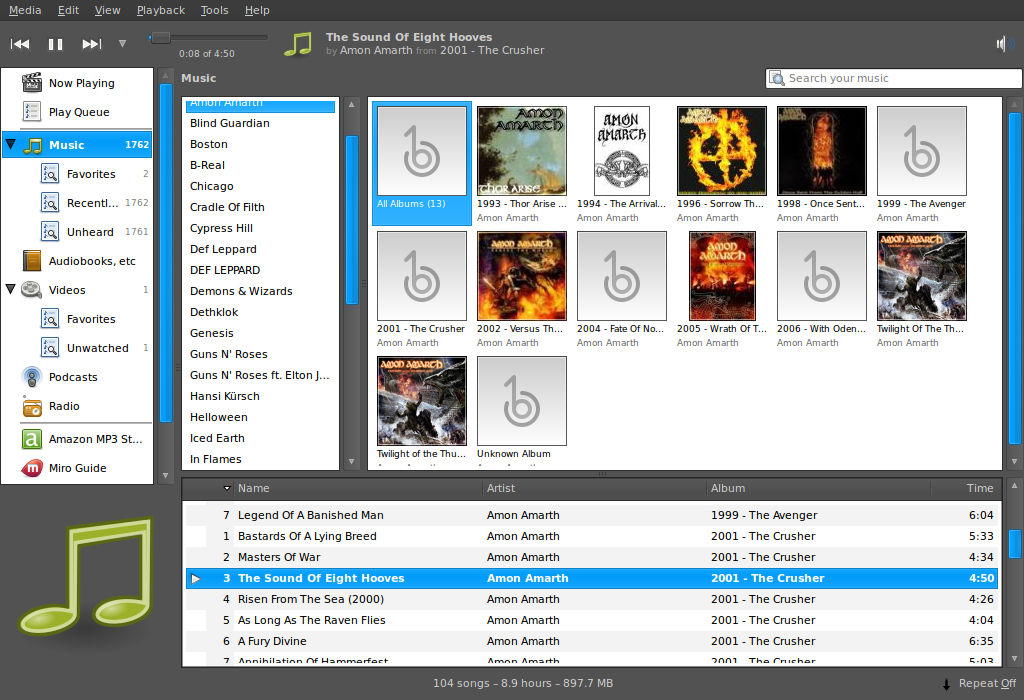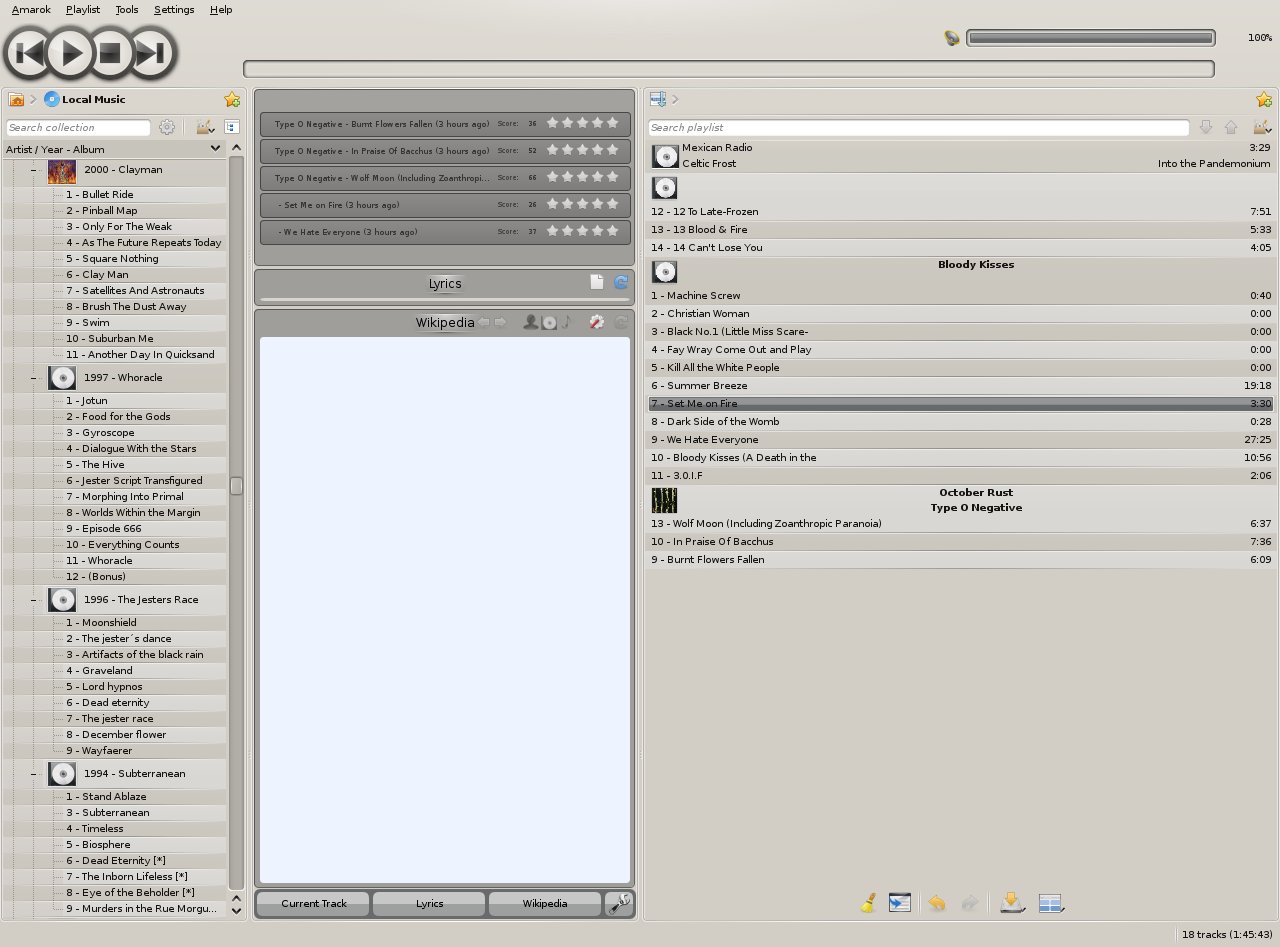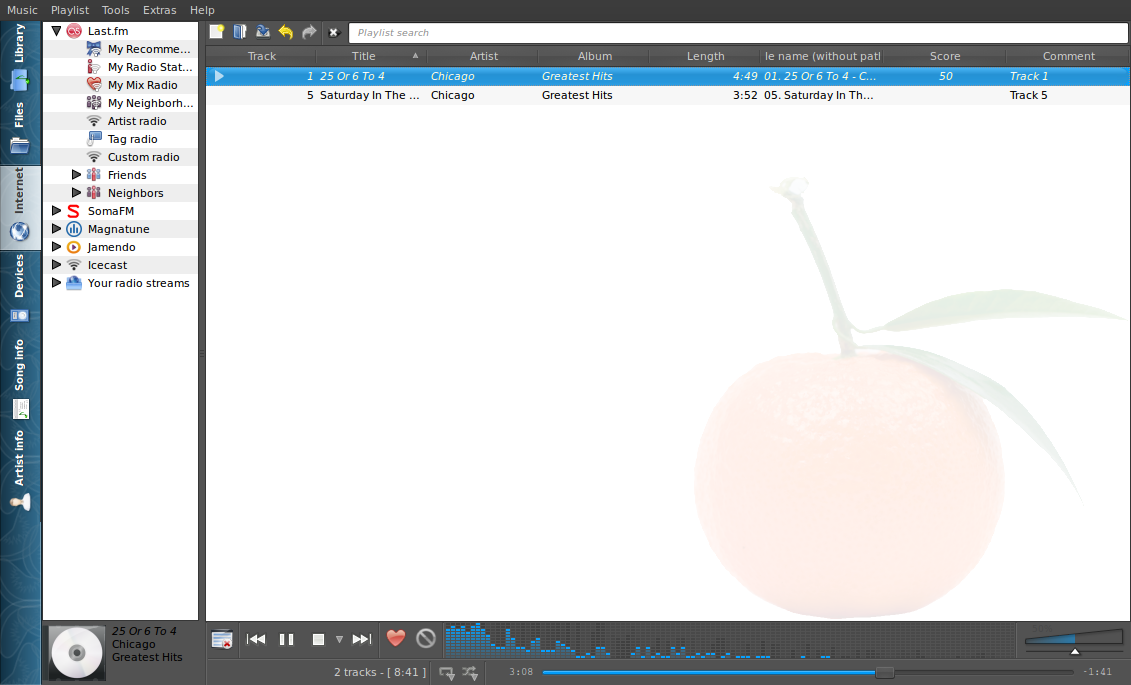Tom's Definitive Linux Software Roundup: Audio Apps
Music Managers With iPod Sync
This category is essentially for iTunes replacements. A music manager sets itself apart from simple audio players by incorporating extensive tools for keeping track of a large music collection spanning multiple formats and distribution models, whereas an audio player simply plays back audio files.
Obviously we'll be looking for an iTunes-like feature set, as well as compatibility with the world's favorite line of portable music players as the main criteria here.
Banshee (v. 1.8.0)
Banshee is a feature-rich media manager and arguably the community favorite. Besides locally-stored audio files, Banshee can access files on a local network and play Internet radio stations. This app also plays tracks from Last.fm, Miro, and Internet Archive. Songs can be purchased through the Amazon MP3 Store, eMusic, and there is now a plug-in available for the Ubuntu One Music Store as well.
Our test iPod Nano (fourth-gen) had no issues being recognized and syncing to Banshee. It plays and rips good old-fashioned music CDs, and even sports an equalizer with built-in presets. Banshee can also handle podcasts, audio books, and video files. Technically, this makes Banshee more than a music manager and raises it to the level of a catch-all multimedia consumption powerhouse.
The interface is clean and uses the newer GTK+. The play controls are located just below the menu bar, and navigation between media types, sources, and playlists is done using the left-hand pane. The next pane on the left is an artist list, right before the song area. Songs are displayed as tiles, with the album cover art displayed when it can be fetched. Below all of this is the playlist view. Our one complaint is that many of the functions in Banshee are accessed via the menu bar or a right-click menu. This app could benefit from a toolbar. The notification area icon holds all of the playback controls for easy access when Banshee is minimized (or on another virtual desktop).
Multiple playlists, star ratings, search, and editable track info make Banshee great for organization as well as playback. Playlists can be sorted in a total of 31 ways. Beyond repeat, there are multiple ways to shuffle a playlist (or your entire collection) as well: artist, song, album, score, and rating.
Get Tom's Hardware's best news and in-depth reviews, straight to your inbox.
Banshee is about as close as you're going to get to WinAmp in the Linux ecosystem. Canonical will be replacing Rhythmbox with Banshee as the default music app starting in April with the release of Ubuntu 11.04 'Natty Narwhal.'
Rhythmbox (v. 0.12.5)
Rhythmbox is the default audio application for GNOME and most distributions that ship GNOME, including recent versions of Ubuntu. Rhythmbox can playback most audio file formats, as well as audio podcasts and CDs.
Streaming content, such as Last.fm, and access to online music stores like Jamendo, Magnatune, and Ubuntu One (for Ubuntu users) is supported out-of-the-box. When connected to the Internet, this app automatically fetches album art and lyrics. We observed Rhythmbox automatically detect and add an attached iPod (Nano, fourth-generation) to the list of sources near-instantaneously, and without the need for any kind of setup routine. Rhythmbox can also sub as an audio CD burning application, not only burning new audio discs, but ripping tracks from existing CDs as well.
Amarok (v. 2.2.0)
Amarok is a very robust music management application, and quickly becoming the de facto default of most KDE distributions. Amarok plays online radio, podcasts, and CDs, as well as almost any type of local audio file. Album art, song lyrics, and even Wikipedia info on the current artist are automatically added to the center pane when connected to the Internet.
One thing we did notice was, if you have an enormous music collection, Amarok can slow down a bit. Nothing too major. The audio playback was never affected. But there is a noticeable 1-2 second delay when opening albums to reveal tracks in the media library pane.
Another irritation that we suffered with Amarok was iPod syncing. The iPod Nano we used to check compatibility took a very long time to be recognized by Amarok--several minutes, plenty of time to make the average person think it wasn't working and try it again. With that said, this application has come a long way, and its feature set is as complete as any music manager on the market. Amarok is probably the best pick for KDE users, while GNOME users will most likely be happier with Rhythmbox.
Clementine (v. 0.6 r2402)
Clementine is a music management application built from an old version of Amarok, before the big KDE 4.0 redesign that left many users unhappy. The UI is unlike most other apps out there, but nevertheless easily navigable.
A thin vertical bar along the left-hand side of the screen houses buttons for your library, files, Internet radio, devices, song, and artist info. Selecting these buttons changes the view of the adjacent vertical pane. The main panel contains the currently-selected playlist. An analyzer at the bottom of the screen can be switched between bar, block, boom, sonogram, and turbine--or open another window with visualizations. Built-in visualizations are always nice, but Clementine made our modern test system stutter and crawl.
Support for Internet radio like Jamendo, Last.fm, and Magnatune are supported out-of-the-box, though this player is definitely geared towards Last.fm. Dedicated love/ban buttons exist in the play controls, whether you're listening to a track from Last.fm or elsewhere. An album cover manager displays all album covers as tiles, and contains a tool to fetch any missing art. Clementine has a notification area icon that can be right-clicked to reveal controls for previous, next, play/pause, stop, stop after current track, mute, love, ban, and quit. iPod snyc worked great via the Devices tab.
Current page: Music Managers With iPod Sync
Prev Page Standards, Methodology, Test System Specs, And Legend Next Page Music Managers-
nevertell Great stuff, I'll try out some of those.Reply
Although I had tried Banshee a few years ago, and it just couldn't deal with 30 gb of music. -
machvelocy D'oh.... i didn't know before if you can sync ipod in linux (yes i'm a linux n00b).Reply -
pelov Linux has always been quite robust in the audio segment, particularly if you consider that the majority of apps are completely free and hog less resources. Move over apple.Reply
Though some apps are .deb or .rpm, or what have you, depending on the linux distro you can still open/install them just fine.
Good writeup :) -
haplo602 I miss xmms in the list, just for nostalgia.Reply
Audacious fits my bill for a music player. Simple yet capable. -
admiral_grinder I have tried several of the Winamp clones on my Ubuntu box, but I'm using Audacious to be the better. Out of all the clones I have found the playlist sorting options are a bit weak. While you can sort by Artist or by Title, you can't do both. They do have the important one of sorting by path and filename though so you can que up albums in the right order.Reply -
castlefox Thank you Toms for doing a linux article !!!!!Reply
I didnt know those ipod syncing programs actually worked. I cant wait to try out Banchee in Ubuntu 11.04
PS> Type O Negative and all the other metal put a smile on my face :) -
Crazy Hitchhiker Nice to see that you are still doing linux articles! I'm a little curious why several programs were left off, though: VLC, Audacity, and WinFF. Oh well, just keep up the good work!Reply -
castlefox Crazy HitchhikerNice to see that you are still doing linux articles! I'm a little curious why several programs were left off, though: VLC, Audacity, and WinFF. Oh well, just keep up the good work!Reply
VLC is more of a video thing.... it does stand for "video lan client"






















